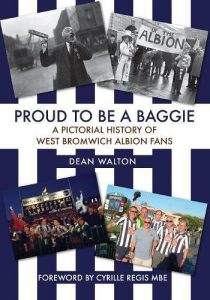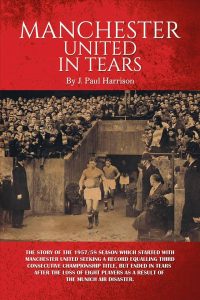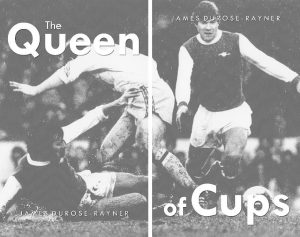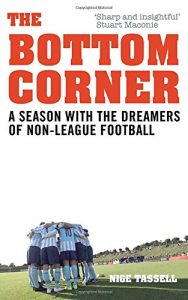Book Review: FOOTBALL – The Golden Age: Extraordinary Images from 1900 to 1985 by John Tennant
 The title makes the big claim that it is portraying ‘the golden age’ of football and then sets about trying to prove it in glorious black and white. Now I was alive in 1985 and can confirm that the world did not suddenly spring into colour in 1986. Why isn’t there a single colour photo used? High art or just to save money? There are, though, some great photographs, but whether they combine to prove the ‘big claim’ is hard to say. Unless, that is, there is something golden about not having modern technology and facilities.
The title makes the big claim that it is portraying ‘the golden age’ of football and then sets about trying to prove it in glorious black and white. Now I was alive in 1985 and can confirm that the world did not suddenly spring into colour in 1986. Why isn’t there a single colour photo used? High art or just to save money? There are, though, some great photographs, but whether they combine to prove the ‘big claim’ is hard to say. Unless, that is, there is something golden about not having modern technology and facilities.
Being much more about the peripherals of football, you will search long and hard for ‘extraordinary images’ of the great players doing great things in an actual match. No George Best working his magic, no Dixie Dean, no action from England’s win in ’66…
All of this, John Tennant admits to in his Foreword. Strange how he wasn’t willing to make a stand and insist on the book being called, to use his own words, “The seemingly inconsequential moments that every fan cherishes.”
That said, the book is a lot of fun. The captions are crucial, but it is still interesting to consider how photographs can lose their cultural significance over time and how much more explanation is needed as the years go by. Two examples stand out; people of a certain age will perhaps need just a little bit of help to figure out why the players are observing a minute’s silence at Craven Cottage in November 1963 whilst the American flag is being flown at half-mast (Page 116). People younger than that certain age will probably shrug in puzzlement even when it is fully explained to them before switching their gormless attention back to their beloved phones. The second is on Page 130 – Who is the bald guy in a track suit trying to stop two players swapping shirts? Is he hoping to snaffle one to sell on eBay? It is none other than Alf Ramsey in the process of getting George Cohen to unswap his shirt with an Argentinian ‘animal’ in 1966. Forgotten by time? Possibly. But, did it contribute to the Falklands War? More than possible.
It is pointless trying to say which are the best. That’s far too subjective, but here is my Top 20, in page order.
- Page 23 – Yeovil beating Sunderland in the FA Cup, 1949. Nothing unusual these days in that result. but a shock then. The picture of the cheering fans is completely eclipsed by two boys wrestling on the pitch-side. It brings back memories of an expression which is splendidly un-PC and completely absent from Google, ‘like two boy scouts in a sleeping bag!’
- Page 45 – Pools winner, 1930s. An absolute beauty! On the facing page is a delighted pools winner grasping his cheque but this image is of a sour-faced old geezer with a Hitler moustache who is about as happy as Mein Fuhrer would have been had he been summoned from his bunker for such a promo.
- Page 60 – Edward, Prince of Wales (destined to be an ex-king) kicking off a match, 1923. Like the photo on Page 23, it’s the small detail that is priceless. As the dapper Royal swings a leg what we notice is that in his right hand he is toting a gun. Now if you want to see someone kick off with real style, great balance and not a single gun, turn to Page 332 where the Hon. Irene Lawley shows how it’s done, fur-trimmed coat and all (1916)
- Page 126 – Cardiff City crowd, 1921. There is something stunning, perhaps even shocking to modern spectators that blokes would climb on to the roof of the unfinished stand. There are dozens of them in the photo. It probably needs pointing out that matches weren’t always all-ticket, seats guaranteed. Another along similar lines is on Page 301 (1945) only this time they have an actual roof to sit on and watch the game.
- Page 130 – the World Cup shirt non-swap, 1966. See above about the Argy bargy. (Sir) Alf said, ‘Our best football will come against the right type of opposition—a team who come to play football, and not to act as animals.’ Or use the Hand of God?
- Page 164 – Hackney Marshes, 1962 (although some sources say the 1950s). A rightly celebrated aerial view of literally dozens of games taking place. It really is a great photograph. The mystery is, how come whoever took it failed to get any credit for it?
- Page 182 – Boy being passed to the front, 1930. In a forerunner of crowd surfing the kid in question is a West Ham fan, but it happened everywhere in the ‘good old days’.
- Page 189 – the new stand at White Hart Lane, 1934. A nice contrast with the computer designed super stadium built to replace this old ‘new’ stand.
- Page 237 – The FA Cup being taken on the London Underground, 1964. An astonishing picture of Ron Greenwood casually chatting to someone on a tube train whilst holding something on his lap shrouded in a blanket, intended to completely fool all would-be thieves. It can only be a miniature statue of Christ the Redeemer or the FA Cup. Contrast this with the photo on Page 254 of One European Cup, One swimming pool, One Liverpool manager (Joe Fagan) and Two armed Italian guards, stationed there presumably to keep an eye on Fagan.
- Page 241 – Leicester City players take lunch together twice a week to help boost team spirit, 1949. Looks like a Sally Army soup kitchen.
- Page 256 – Annual street football game, Atherstone, 1914. Again, someone steals the picture. Despite the lively scene in a time when almost all men wore hats, it is the kilted, uniformed Scot with the mighty sporran that catches the eye. ‘Let the wind blow high…’
- Page 259 – German players doing the Hitler salute at White Hart Lane, 1935. The little man is referenced again! There is also a photo of a Zeppelin hovering over Wembley, 1930 (Pages 34-5) to remind people of a time when we weren’t best buddies with our (for now) EC partners.
- Pages 308-9 – Mothers with babies queue at Gateshead Town Hall for Cup tickets, 1953. A really atmospheric photo of an orderly queue of folk and, in the foreground, ranks of parked prams.
- Page 315 – Greaves bathing with injured shin, 1966. A photograph of THE finest striker of all, as Rodney Marsh asserts in the Introduction, although the book never tries to support this claim with any goal mouth action featuring a man who scored 466 times. In the days before substitutes, the shin injury to Jimmy Greaves cost him his place in the World Cup Final. Here, he is shown in the bath (pretty grotty looking, it is too) with his injured left leg resting on a chair that has been plonked in it! Jimmy doesn’t look very happy with life.
- Page 333 – England Ladies v France Ladies, 1925. Having reviewed the photograph somewhere in the region of 40 or 50 times, I am slowly coming to the conclusion that the lingering French Kiss between the two captains prior to kick off was not fully justified.
- Page 342 – Unidentified goalkeeper practises kicking, 1939. Perhaps the closest sporting likeness in terms of ungainliness to this unfortunate image of a headless goalie, athletically showing the worst of himself immediately post kick, is when Inzamam ul Haq ingloriously straddled his stumps the time he ‘couldn’t quite get his leg over’.
- Page 354 – The England squad at breakfast, a day before the World Cup Final, 1966. A superb study of nervous young men. Has ever a more thought-ridden spoonful of cereal been eaten than Bobby Charlton’s? Peter Bonetti must be thinking about the nightmare game he is going to have in four years’ time against West Germany, Martin Peters is pensiveness plus, whilst Geoff Hurst looks accusingly straight at the camera. ‘How dare you intrude?’
- Page 357 – The Anfield boot-room, 1980. The legendary place where so many trophy wins were plotted by Paisley, Fagan et al. The photo is a nicely balanced composition that captures the main men in a relaxed manner which is quite an art with a camera using a flash for indoors.
- Page 366 – Booby Charlton recovers in a Munich hospital, 1958. Of course you need the back story but, once you have it, the picture of a bewildered young man is heartbreaking.
- Pages 378-9 and just to show that they could have done it all along, the final photograph is a double page spread and a magnificent one, too. It is of the 1954 FA Cup Final as Ronnie Allen scores a penalty equaliser for West Brom v Preston. It has everything since it is a long-range image of the scene. The penalty action can clearly be seen, with the ball entering the net, the goalie diving the right way but in vain and Ronnie Allen watching keenly. We also have almost all the players in shot, mostly standing calmly with hands on hips. We have a large section of the Wembley crowd in clear focus, the whole length of the famous turf and the West Brom goalie, looking away from the action and clutching one of his posts, too nervous to look.
It is a good book, as it stands, but why couldn’t we have had lots more of such great pictures of the ‘Golden Age’?
(Most of the images are from Getty, followed by Popperfoto, Science & Society Picture Library and Topham Picturepoint)
Graeme Garvey
 The disastrous performance by Loris Karius for Liverpool in the Champions League Final against Real Madrid is just another reminder of the vulnerable role of the goalkeeper, someone who is always walking a tightrope between would-be hero and scapegoat for any failure. The worst thing is that the goalkeeper himself believes this. No such self-doubt seems to exist with attackers like Cristiano Ronaldo. All the glory is his, any failure is somebody else’s fault – every single time.
The disastrous performance by Loris Karius for Liverpool in the Champions League Final against Real Madrid is just another reminder of the vulnerable role of the goalkeeper, someone who is always walking a tightrope between would-be hero and scapegoat for any failure. The worst thing is that the goalkeeper himself believes this. No such self-doubt seems to exist with attackers like Cristiano Ronaldo. All the glory is his, any failure is somebody else’s fault – every single time. The 2017/18 season could not be described as one of the best for West Bromwich Albion (WBA). Not only did they suffer relegation from the Premier League whilst Black Country rivals Wolves leapfrogged them after being promoted, but Baggies legend Cyrille Regis unexpectedly passed away in January 2018.
The 2017/18 season could not be described as one of the best for West Bromwich Albion (WBA). Not only did they suffer relegation from the Premier League whilst Black Country rivals Wolves leapfrogged them after being promoted, but Baggies legend Cyrille Regis unexpectedly passed away in January 2018. The Munich Air Disaster that took place on 6 February 1958 will forever be part of the history of Manchester United and in the period since the tragic event, it has been covered in documentaries, TV dramas, music and most especially in books.
The Munich Air Disaster that took place on 6 February 1958 will forever be part of the history of Manchester United and in the period since the tragic event, it has been covered in documentaries, TV dramas, music and most especially in books. It’s probably because so much is hinted at in the title that he couldn’t resist the temptation. Plus there is a striking cover picture of Gazza, as I recall. A successful book, like a baited hook, attracts and then captures the reader. I think it could be true in this case but I really don’t know yet since someone has got my review copy and won’t give it back!
It’s probably because so much is hinted at in the title that he couldn’t resist the temptation. Plus there is a striking cover picture of Gazza, as I recall. A successful book, like a baited hook, attracts and then captures the reader. I think it could be true in this case but I really don’t know yet since someone has got my review copy and won’t give it back! When you think of subjects at the centre of a novel, football clubs and their local council, are not the most obvious that spring to mind. However, the reality is that as recently as last year, Championship side Millwall almost lost its stadium to a sinister development plan instigated by the local Labour council. Indeed, the further you delve back, the more ‘interesting’ deals you come across, such as the missing £10million pound loan from Northampton Borough Council that was due to finance the building of a new stand at Northampton Town. Football and local councils – institutions bound together, both prone to dodgy deals and the oft lingering whiff of corruption, as potent as any matchday smell of burgers and fried onions.
When you think of subjects at the centre of a novel, football clubs and their local council, are not the most obvious that spring to mind. However, the reality is that as recently as last year, Championship side Millwall almost lost its stadium to a sinister development plan instigated by the local Labour council. Indeed, the further you delve back, the more ‘interesting’ deals you come across, such as the missing £10million pound loan from Northampton Borough Council that was due to finance the building of a new stand at Northampton Town. Football and local councils – institutions bound together, both prone to dodgy deals and the oft lingering whiff of corruption, as potent as any matchday smell of burgers and fried onions.

 Author Neil Cotton is a self-confessed Cup-fanatic, which came about from the first ever football match he attended, which was a 1994 Coca-Cola League Cup at The Dell between Southampton and Huddersfield Town.
Author Neil Cotton is a self-confessed Cup-fanatic, which came about from the first ever football match he attended, which was a 1994 Coca-Cola League Cup at The Dell between Southampton and Huddersfield Town. “Everyone loves an FA Cup upset: a smug Premier League team being knocked out by plucky underdogs.”
“Everyone loves an FA Cup upset: a smug Premier League team being knocked out by plucky underdogs.”